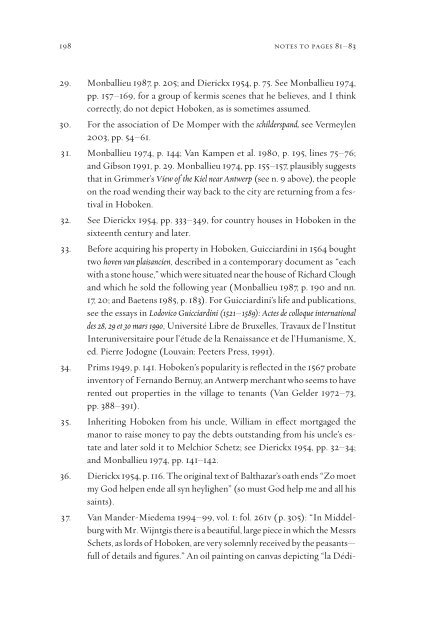Pieter Bruegel and the Art of Laughter - AAAARG.ORG
Pieter Bruegel and the Art of Laughter - AAAARG.ORG
Pieter Bruegel and the Art of Laughter - AAAARG.ORG
Create successful ePaper yourself
Turn your PDF publications into a flip-book with our unique Google optimized e-Paper software.
198 notes to pages 81–83<br />
29. Monballieu 1987, p. 205; <strong>and</strong> Dierickx 1954, p. 75. See Monballieu 1974,<br />
pp. 157–169, for a group <strong>of</strong> kermis scenes that he believes, <strong>and</strong> I think<br />
correctly, do not depict Hoboken, as is sometimes assumed.<br />
30. For <strong>the</strong> association <strong>of</strong> De Momper with <strong>the</strong> schildersp<strong>and</strong>, see Vermeylen<br />
2003, pp. 54–61.<br />
31. Monballieu 1974, p. 144; Van Kampen et al. 1980, p. 195, lines 75–76;<br />
<strong>and</strong> Gibson 1991, p. 29. Monballieu 1974, pp. 155–157, plausibly suggests<br />
that in Grimmer’s View <strong>of</strong> <strong>the</strong> Kiel near Antwerp (see n. 9 above), <strong>the</strong> people<br />
on <strong>the</strong> road wending <strong>the</strong>ir way back to <strong>the</strong> city are returning from a festival<br />
in Hoboken.<br />
32. See Dierickx 1954, pp. 333–349, for country houses in Hoboken in <strong>the</strong><br />
sixteenth century <strong>and</strong> later.<br />
33. Before acquiring his property in Hoboken, Guicciardini in 1564 bought<br />
two hoven van plaisancien, described in a contemporary document as “each<br />
with a stone house,” which were situated near <strong>the</strong> house <strong>of</strong> Richard Clough<br />
<strong>and</strong> which he sold <strong>the</strong> following year (Monballieu 1987, p. 190 <strong>and</strong> nn.<br />
17, 20; <strong>and</strong> Baetens 1985, p. 183). For Guicciardini’s life <strong>and</strong> publications,<br />
see <strong>the</strong> essays in Lodovico Guicciardini (1521–1589): Actes de colloque international<br />
des 28, 29 et 30 mars 1990, Université Libre de Bruxelles, Travaux de l’Institut<br />
Interuniversitaire pour l’étude de la Renaissance et de l’Humanisme, X,<br />
ed. Pierre Jodogne (Louvain: Peeters Press, 1991).<br />
34. Prims 1949, p. 141. Hoboken’s popularity is reflected in <strong>the</strong> 1567 probate<br />
inventory <strong>of</strong> Fern<strong>and</strong>o Bernuy, an Antwerp merchant who seems to have<br />
rented out properties in <strong>the</strong> village to tenants (Van Gelder 1972–73,<br />
pp. 388–391).<br />
35. Inheriting Hoboken from his uncle, William in eªect mortgaged <strong>the</strong><br />
manor to raise money to pay <strong>the</strong> debts outst<strong>and</strong>ing from his uncle’s estate<br />
<strong>and</strong> later sold it to Melchior Schetz; see Dierickx 1954, pp. 32–34;<br />
<strong>and</strong> Monballieu 1974, pp. 141–142.<br />
36. Dierickx 1954, p. 116. The original text <strong>of</strong> Balthazar’s oath ends “Zo moet<br />
my God helpen ende all syn heylighen” (so must God help me <strong>and</strong> all his<br />
saints).<br />
37. Van M<strong>and</strong>er-Miedema 1994–99, vol. 1: fol. 261v ( p. 305): “In Middelburg<br />
with Mr. Wijntgis <strong>the</strong>re is a beautiful, large piece in which <strong>the</strong> Messrs<br />
Schets, as lords <strong>of</strong> Hoboken, are very solemnly received by <strong>the</strong> peasants—<br />
full <strong>of</strong> details <strong>and</strong> figures.” An oil painting on canvas depicting “la Dédi-












